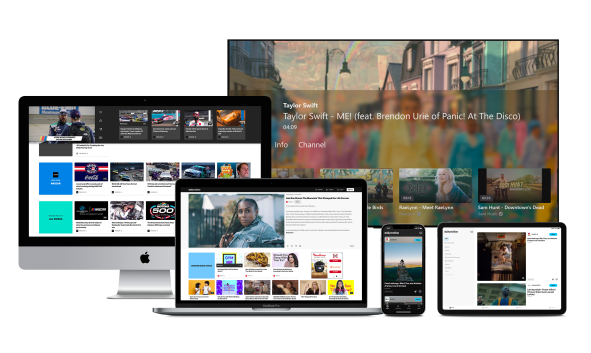Video Asset Management: Definition and Benefits
Video content carries significant weight, you know. They’re weightier than any other type of media. So, when you keep piling up more and more videos, the task of efficiently sorting and managing these assets turns increasingly challenging.
This is where Video Asset Management (VAM) comes into play. From effectively storing, organizing, and sharing videos to easily searching for specific content, VAM empowers businesses to fundamentally transform their video content management and distribution processes. With a comprehensive approach to managing video assets, businesses can enhance collaboration, save time and resources, and improve the overall effectiveness of their video content strategies.
But what exactly is video asset management, and why is it crucial for your business? We’ll clarify everything and guide you in selecting the best solution. Additionally, we will share the best strategies to guarantee the optimal management of your precious video assets.
What is Video Asset Management (VAM)?
Video Asset Management is the process of effectively organizing, storing, and retrieving digital video content. It provides businesses with a centralized platform for storage and organization, allowing them to easily locate and access their video assets whenever needed, saving time and improving productivity.
VAM also enables businesses to manage metadata associated with video assets, such as titles, descriptions, tags, and timestamps, making it easier to categorize and search for specific videos. . By utilizing this feature, businesses can easily find relevant videos based on specific criteria without having to manually search through numerous files. Additionally, VAM ensures secure storage of video assets, protecting valuable content from loss or unauthorized access while providing easy accessibility to authorized users.

Video Asset Management (VAM), Digital Asset Management (DAM), and Media Asset Management (MAM): How They Differ
Video Asset Management (VAM), Digital Asset Management (DAM), and Media Asset Management (MAM) are all related concepts, but they serve different purposes and have distinct functionalities. Understanding the differences between these management systems is essential for businesses to choose the right solution for their specific needs.
Digital Asset Management (DAM)
Digital Asset Management (DAM) involves the management of various digital assets, including images, documents, audio files, and videos. It focuses on organizing and centralizing all types of digital assets, enabling businesses to easily store, retrieve, and distribute them. DAM systems typically provide features such as metadata management, version control, and rights management to ensure efficient asset management across multiple channels and platforms.
Media Asset Management (MAM)
Media Asset Management (MAM) is a specific type of DAM that specializes in managing media files, including videos, audio files, and images. MAM systems are designed to handle the complexities of media files, such as different formats, resolutions, and bitrates. They often include features like transcoding, metadata extraction, and integration with video editing software. MAM systems are commonly used in industries such as broadcasting, film production, and entertainment, where managing large volumes of media assets is crucial.
Video Asset Management (VAM)
Video Asset Management (VAM) focuses specifically on managing video assets. It provides functionalities that are tailored to the unique needs of video content, such as video playback, video transcoding, and video analytics. VAM systems typically have advanced features like automated metadata extraction, video editing capabilities, and integration with video hosting platforms. They are designed to streamline the management of video content throughout its lifecycle, from creation to distribution.

The Benefits of Video Asset Management Software
Implementing a robust VAM solution offers numerous benefits for businesses in managing their video content effectively. Let’s explore some of the key advantages:
Efficient Organization and Accessibility
Efficient organization and accessibility are crucial elements of effective video asset management. By storing all your videos in one centralized location, you can easily access and manage them without wasting time searching through multiple folders or drives. Metadata tagging further enhances accessibility by allowing you to add relevant information to your videos, making it easier to search for specific content. Furthermore, version control ensures that there are no duplicated files, eliminating confusion and saving valuable storage space. With an efficient organization system in place, your valuable video assets remain organized and accessible at all times while streamlining workflow efficiency.
Enhanced Collaboration
Real-time collaboration on video projects is now made easier with video asset management systems. With centralized access to videos, team members can work together simultaneously, making edits and adjustments in real-time, increasing productivity and efficiency. Moreover, secure sharing of video assets within the team ensures that sensitive information remains confidential while allowing for seamless collaboration.
Time and Cost Savings
Investing in a robust video digital asset management solution empowers your business to make substantial time and cost savings. Reduced time spent searching for specific video files is a significant advantage of implementing video asset management. With a centralized system in place, locating and retrieving the desired footage becomes quick and effortless for your team, boosting productivity and efficiency.
Additionally, the need for physical storage is completely eliminated with video digital asset management. Storing videos digitally eliminates costs associated with physical servers or external hard drives while providing unlimited scalability to accommodate your growing library of content.
Asset Protection and Security
Valuable video content needs to be protected from loss or unauthorized access. Video digital asset management provides security measures such as user authentication, access controls, and encryption to safeguard video assets. This ensures that only authorized users can access and utilize the content, minimizing the risk of data breaches or unauthorized distribution.
Analytics and Insights
Video digital asset management platforms often come with built-in analytics tools that provide valuable insights into the performance and engagement of video content. Businesses can track metrics such as views, click-through rates, and viewer demographics to measure the effectiveness of their video assets and make data-driven decisions.

Choosing the Right Video Asset Management Solution
Selecting the right video digital asset management solution is crucial for maximizing the benefits and efficiency of managing your video assets. Here are some key steps to guide you in choosing the right solution for your business:
Identify Your Business Needs
Before choosing a video digital asset management solution, it is crucial to identify your specific business needs. Consider your industry-specific requirements, such as compliance regulations or customer expectations for high-quality videos. Additionally, identify your business needs such as the volume of videos you handle, the complexity of your workflows, and any unique requirements or challenges that may hinder efficient management of video assets. Understanding your needs will help you select a solution that aligns with your goals and maximizes efficiency.
Evaluate Available Options
Once you have identified your business needs, carefully evaluate the available options in the market to find the right fit for your business. Look for features like robust metadata capabilities, advanced search functionalities, customizable user interfaces, and secure storage options. Additionally, consider factors such as vendor reputation, user reviews, and testimonials to ensure that the chosen solution meets both your present requirements and future growth plans effectively.
Consider Scalability and Integration
Ensure that the chosen video digital asset management solution is capable of handling your current volume of video assets effectively. Evaluate its scalability to accommodate future growth as your business expands. Moreover, check if it seamlessly integrates with existing software or tools you utilize, streamlining your workflow and enhancing productivity. Additionally, consider the level of support and training provided by the software vendor to ensure a smooth implementation process.

Best Practices for Video Asset Management
To optimize the management of your video assets and ensure efficient operations, consider implementing the following best practices:
1. Establishing a Consistent Naming Convention
Standardize file names to improve searchability in your video digital asset management system. By using a consistent naming convention, you can streamline the management process and save time when searching for specific videos. Include relevant details in the file names, such as date, project name, or content description to provide additional context for easy identification. Avoid using special characters or spaces in file names to prevent any potential issues with compatibility across different platforms.
2. Implementing Metadata and Tagging
Attach descriptive metadata and tagging to video assets for added context, allowing for easier organization and retrieval. Adding relevant information such as keywords, descriptions, and categories enables efficient sorting, filtering, and locating of videos within your asset management system. Additionally, customizable metadata fields allow you to tailor the information based on your business requirements, ensuring accurate data management for optimal video asset organization.
3. Regularly Backing Up Your Video Assets
Regularly backing up your video assets is essential to protect against data loss or corruption. Implement a robust backup strategy that includes both on-site and off-site backups to ensure the safety of your valuable video content. Storing backups in multiple locations adds an extra layer of protection against hardware failures, natural disasters, or other unforeseen events. Regularly test the restoration process to ensure that your backups are functioning correctly and to identify any issues before they become critical.
4. Training and Onboarding
Educate employees on the importance of video digital asset management practices to maximize efficiency and productivity. Provide comprehensive training sessions that cover best practices, workflows, and any software tools used in managing video assets. Additionally, incorporate regular refresher courses to ensure that everyone stays up-to-date with the latest practices, allowing for seamless collaboration throughout the organization’s workflow.

Dailymotion Video Asset Management Solution: Your Ultimate Solution
Now that you’re fully informed about VAM, is there a solution that meets all your requirements? Indeed, if you’re adopting VAM for the first time, we recommend Dailymotion.
Dailymotion’s comprehensive Video Asset Management solution offers all the essential tools for your business to upload, store, organize, distribute, and optimize digital video content, regardless of scale. Moreover, our strong storage capacity and advanced management system ensures that your valuable video assets are managed efficiently and securely.
- Robust Storage Capacity: Our solution provides ample storage space to accommodate your growing library of video assets, ensuring that you never run out of storage.
- Efficient Organization: With Dailymotion’s video management solution, you can efficiently organize your video assets in one centralized location, making them easily accessible to your team.
- Advanced Metadata Capabilities: Our solution allows you to add descriptive metadata and tags to your video assets, enhancing searchability and categorization.
- Analytics and Insights: Dailymotion’s video management solution comes with built-in analytics tools that provide valuable insights into the performance and engagement of your video content, helping you make data-driven decisions.
- Secure Sharing and Collaboration: Dailymotion allows you to safely share and work together on video projects in real-time. By setting various permission levels for each team member, you can guarantee the confidentiality of sensitive information.
- Integration with Existing Tools: Our solution seamlessly integrates with popular content management systems with our robust APIs and SDKs, allowing for a smooth workflow and enhancing productivity.
- Training and Premium Support: Dailymotion provides dedicated training and premium support to ensure a smooth implementation of our video management solution with your existing tools.
By utilizing Dailymotion’s Video Asset Management Solution, your business can streamline the management of video assets, enhance collaboration, and maximize the efficiency of your video marketing strategies.

Conclusion
In conclusion, effective video digital asset management is crucial for businesses to maximize the potential of their video content. By implementing a robust video management solution like Dailymotion’s, businesses can efficiently organize and access their video assets, enhance collaboration among team members, save time and resources, and make data-driven decisions based on valuable analytics and insights.
Don’t let the increasing volume of video content overwhelm your organization. Take advantage of video digital asset management to unlock the power of your video assets and maintain a competitive edge in the dynamic digital landscape.
Contact us today and discover how Dailymotion’s video management solution can transform the way you manage your video assets and enhance your video content strategies.
FAQ
What is asset management in film?
Asset management in the context of film refers to the organized and systematic control of all digital assets related to video content, including video files, audio, images, and metadata. It involves cataloging, storing, and retrieving these assets efficiently.
What are the benefits of video asset management?
The benefits of video asset management include improved content organization, easier access for collaboration, enhanced security and rights management, streamlined content distribution, and better analytics for understanding audience engagement.
What is video asset?
A video asset is any digital element used in video production, such as video clips, audio files, images, graphics, or subtitles, that contributes to the overall content. These assets are managed to ensure they are organized and readily available for editing and distribution.
What is visual asset management?
Visual asset management is a broader term that encompasses the management of all visual content, not just video, including images, graphics, and other visual elements. It involves organizing, storing, and retrieving these assets to support various marketing and content creation needs.
